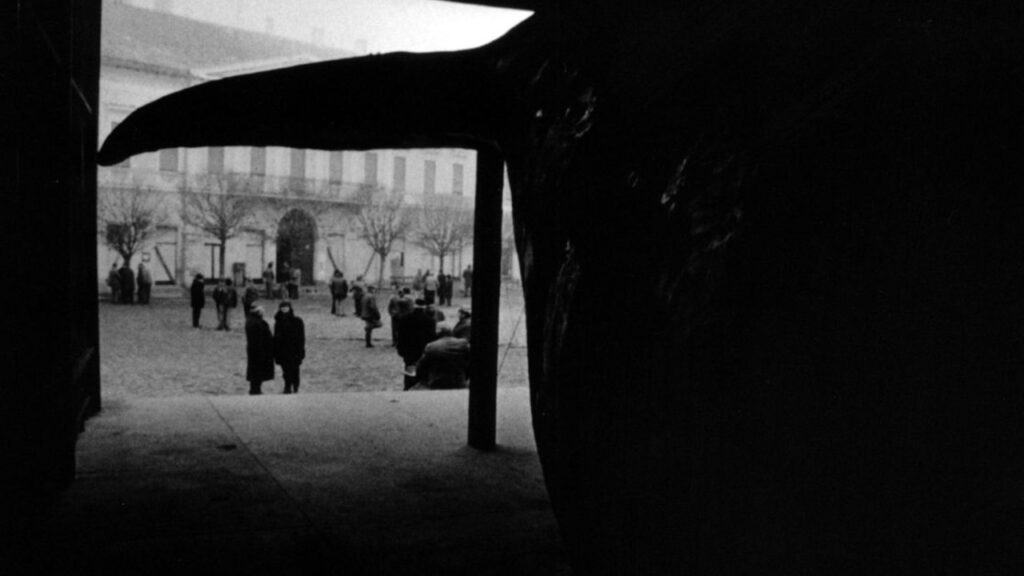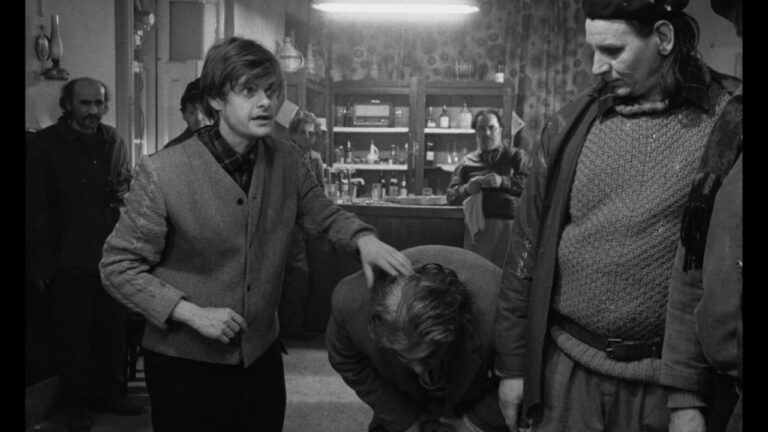Béla Tarr’s ‘Werckmeister Harmonies‘ is an austere vision of cosmic indifference and social decay, a film that transforms the frozen streets of a provincial Hungarian town into an allegory of civilization’s exhaustion. Shot in a glacial monochrome and composed of thirty-nine long, seamless takes, it is less a narrative than a series of metaphysical observations, each movement unfolding with the certainty of a dying star. Tarr and his collaborator László Krasznahorkai reconstruct the ruins of a society that has lost faith in both reason and transcendence, revealing a world where every attempt to impose order is bound to corrode into chaos.
The story follows János Valuska, who is a very kind-hearted young man, moving between the townspeople performing odd tasks and seeking fragile connections in a world that seems to have forgotten how to feel.
Béla Tarr’s Winter Town Faces the Rise of Fear, Hysteria, and Ethical Paralysis

The opening sequence sets the tone for everything that follows. Inside a dimly lit tavern, János instructs a group of drunken men to imitate the celestial movements of the Sun, Earth, and Moon. For a brief moment, he creates a vision of cosmic order. The image of bodies rotating around one another in choreographed stillness hints at a harmony that the rest of the film methodically dismantles. Once outside, the streets lie frozen and empty, and the fragile warmth of that illusion dissipates.
After some time, we see a traveling circus soon arrives in town, and its central attraction is a massive, embalmed whale, carted in a steel container, and the rumor that the show’s owner travels with a mysterious figure known only as “The Prince.” The whale is immense in nature and decaying, which eventually becomes an object of obsession and fear. People queue to gaze at it in silence, as though staring into something divine or monstrous. The Prince, never seen directly, is said to speak through interpreters, delivering cryptic speeches that inflame the townspeople’s resentment and despair. The circus, which should have brought wonder, instead becomes a catalyst for hysteria.
János’s guardian, György Eszter, a reclusive music theorist, is preoccupied with the problem of harmonic systems. He believes that the eighteenth-century tempering devised by Andreas Werckmeister corrupted the purity of natural sound to produce rational order. To him, this distortion is emblematic of human civilization itself and how the world has been tuned for convenience, and in the process, truth has been lost. His withdrawal from society mirrors the larger spiritual decay of the town.
As unrest grows, the Prince’s influence turns rumor into riot. The townspeople, driven by a sense of grievance and collective delusion, march through the streets at night. Tarr films their advance in a long, unbroken take that strips away all dialogue and music. They storm a hospital, destroying what they find, until they come upon a frail, old man. Faced with the undeniable presence of human vulnerability, the mob stops. The violence collapses into silence. It is the film’s only moment of moral recognition, and it lasts barely a heartbeat.
The town sinks into paralysis. János, broken by what he has witnessed, is taken away to an asylum. György, once obsessed with correcting the world’s dissonance, now accepts the futility of his pursuit. The whale lies abandoned in the square, devoid of mystery, its vast body rotting in the cold. In the final image, the whale stands motionless in the square, exposed to the cold air. It is both relic and corpse, symbol and object. János no longer looks at it with awe; he simply sees it. The mystery has been emptied, and what remains is the fact of existence itself.
Tarr closes his film not on revelation but on perception, the act of seeing after all meanings have failed. Werckmeister Harmonies ends with stillness rather than resolution. All systems, musical, moral alike, have collapsed, and what remains is the faint hum of existence, which is indifferent, as well as impenetrable, resonating through an emptied world.
Werckmeister Harmonies Utilizes Circular Time, Stasis, and Patience to Examine the Inevitability of Decay and Emptiness

The nature of the film is not built around a conventional plot but around the gradual collapse of meaning. Tarr uses long takes to erase the boundaries between event and duration. Each scene unfolds at the pace of real time, forcing the viewer to live inside decay rather than merely observe it. Movement in the film does not signal progress; it signals repetition and stasis. Even when people walk, they appear trapped in an invisible pattern. Time becomes circular, not linear, which mirrors the philosophical despair of a society unable to imagine renewal.
The film’s structure depends on the contrast between the infinite and the banal. János’s imagination of cosmic harmony stands beside the crude realities of poverty, confusion, and superstition. The celestial model he enacts in the opening is a fantasy of order, but it cannot survive the corruption of earthly life. By the time things escalate, the town has become a distorted version of that opening image. Everybody is moving together without direction, orbiting around nothing. Tarr’s use of light and darkness reinforces this collapse. The whiteness of snow suggests purity but becomes a screen for emptiness; darkness hides both danger and fatigue.
Werckmeister Harmonies also functions as a political parable, though one unburdened by slogans or direct commentary. The Prince embodies the mechanisms of manipulation that exploit despair. His unseen presence magnifies the film’s sense of unease, suggesting how easily collective frustration turns into violence when guided by vague authority. The riot sequence reads as an allegory for the failure of ideological systems, whether totalitarian or democratic, that promise renewal but deliver ruin. Tarr does not moralize. He observes the inevitability of decay, as if social disintegration were another natural law.
The film’s refusal of emotional climax or redemption makes it deeply unsettling. Tarr presents no catharsis, no transformation, only exhaustion. What distinguishes Werckmeister Harmonies is its commitment to endurance as form. Every shot insists on the viewer’s patience, extending moments until their meaning dissolves. This duration transforms stillness into the subject itself, and by stretching time, Tarr reveals how existence continues even after purpose has vanished. The result is not pessimism but precision; after all, it is a world viewed without illusion, where the beauty of the image and the emptiness of its content coexist without contradiction.




